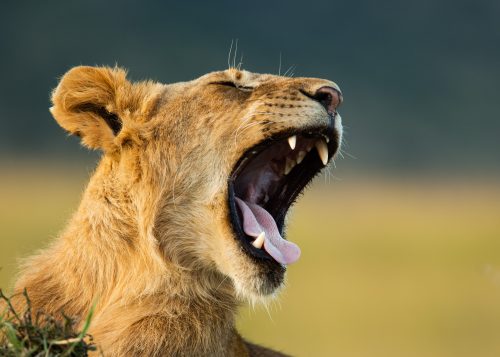Driving down the escarpment as the sun rises, the landscape is transformed by a cascade of warm hues that envelop the plains. During our descent, a group of robust dagga boys (old buffalo bulls), undisturbed by the rumbling engine, leisurely stretch and absorb the morning heat — our first sighting of the day.
Moments later, as I glance back at the escarpment, the views only intensify. A majestic assembly of giraffes stand tall, bathed in the morning glow that highlights the whites peeking through their distinctive patterns. The Oloololo Escarpment serves as a striking backdrop, cloaked in a shimmering green hue, while lingering partial clouds add a touch of ethereal beauty to the brisk morning air. Above it all, the sky completes the picturesque scene with dramatic clouds, creating a visual symphony of layers and lines that captivate the eye. As a photographer, my perspective is attuned to these intricacies, observing the seamless composition from the ground to the escarpment and the expansive canvas of the sky.
While observing these towering giants, our attention was drawn to a lively spectacle unfolding within the group. A male was passionately courting a female, who was unmistakably in the throes of her mating season. The persistent male was strategically positioning himself to impede the female's movement. Being non-territorial where boundaries are not a concern, this behaviour suggests that the male was likely trying to prevent the female from straying too far, avoiding potential encounters between the female and other suitors.
Continuing our drive, we came upon a lone leopard cub perched in a tree with a carcass concealed in the tree's canopy. The young feline, already displaying remarkable comfort in its elevated domain, appeared relaxed and well-fed in the soft morning glow. Mindful of the mother's likely proximity, we maintained a respectful distance, fully aware that her watchful eyes were undoubtedly fixed on her young one.
As we quietly observed, the small cub initiated its descent. Though a bit awkward, it confidently utilised its sharp claws to navigate down the tree trunk. After a brief pause to survey the safety of its surroundings, the descent resumed, culminating in a somewhat clumsy landing with the cub's face meeting the ground.
After it regained its composure from its face plant, the young leopard suddenly took off running. Our gaze followed the cub's sprint, revealing the mother halfway between the tree and a bush where she had been concealed. Her raised tail served as a clear signal to the cub of her position, and, once united, they retreated into a dense thicket. Later, we learnt that the mother returned to collect the remaining carcass from the tree, and hid it somewhere the cub could feast without disturbance.
Driving back to camp, we noticed a sub-adult male lion at Hippo Pool on the very edge of the Mara River. It was one of three boys belonging to the Swamp lioness. Upon closer observation, it became evident that the lion faced a considerable dilemma when looking at the dead hippo — the high presence of crocs. This particular location makes an anabranch in the River — a separated section of the main Mara River that eventually rejoins the main flow.
The high water level in the main River has prompted a remarkable shift in the behaviour of crocodiles, leading them to congregate in unusually large numbers within the anabranch. This specific section, characterised by its lower water level, has become a hotspot for these aquatic predators and it is a sight to behold. –Robert Sayialel
The majestic bull elephants have returned to Kimana Sanctuary, offering our guests the quintessential Amboseli experience. This week, we were treated to breathtaking scenes featuring these magnificent tuskers against the iconic backdrop of Mount Kilimanjaro. Among them are two notable future Super Tuskers: Chemosit and Emoroo.
In the Amboseli ecosystem, you'll find the eastern white-bearded wildebeest, which lives in Kenya and Tanzania, to the east of the Great Rift Valley. Unlike their migrating relatives found in the Maasai Mara and Serengeti, these have a lighter grey colour and a distinctive white beard, unlike most other subspecies which have a black beard.
An interesting feature of wildebeest is that their calves are born with a different colouration. This changes as they mature and the colour they develop depends on the environment they grow up in. This unique adaptation acts as a form of camouflage, helping them evade predators throughout their lifespan, which can last up to 40 years.
If an eagle and a saddle-billed stork had a baby, it would probably look like a secretary bird. This bird has an eagle-like head and long, sturdy legs reminiscent of a stork, which are its main characteristics. Secretary birds are fascinating raptors known for their prowess in hunting snakes specifically.
I had the opportunity to spend some time observing a pair of secretary birds hunting insects here in Kimana Sanctuary. They catch their prey by chasing it down, either striking it with their beak or stomping on it until it's either dead or incapacitated, which makes it easier for the bird to feed, usually in one gulp.
During the hunt, the birds spread their wings and raise the feathered crest on the back of their head. They do cover a lot of ground while hunting, so if you're watching, be prepared to keep up from a safe distance without distressing them.
This week has gifted us with breathtakingly clear vistas of Mt. Kilimanjaro capped with fresh snow. Our talented guest, Laura Aichelburg, skilfully immortalised these moments with her fixed-lens travel camera and we later assisted her in editing some of her best shots. –Sammy Njoroge
Filed under: This Week at Angama
Subscribe for Weekly Stories
Comments (0):

Angama Safari Offers